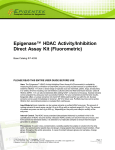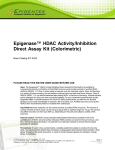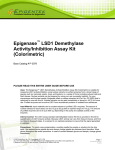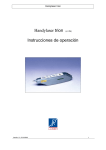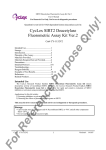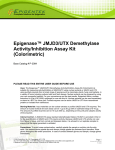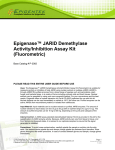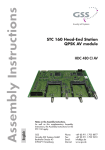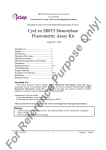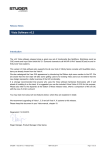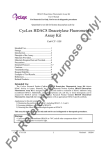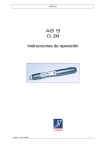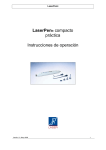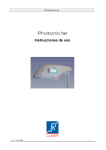Download Epigenase™ Universal SIRT Activity/Inhibition Assay Kit
Transcript
EPIGENTEK Complete Solutions for Epigenetics Epigenase™ Universal SIRT Activity/Inhibition Assay Kit (Colormetric) Base Catalog # P-4036 PLEASE READ THIS ENTIRE USER GUIDE BEFORE USE Uses: The Epigenase™ Universal SIRT Activity/Inhibition Assay Kit (Colorimetric) is suitable for measuring activity/inhibition of total SIRT enzyme using nuclear extracts or purified SIRT isoforms (SIRTs1-7) from a broad range of species such as mammals, plants, fungi, and bacteria, in a variety of forms including, but not limited to cultured cells, fresh and frozen tissues. For SIRT1, SIRT6, and SIRT7, nuclear extracts are required and can be prepared by using your own successful method. For your convenience and the best results, Epigentek offers a nuclear extraction kit (Cat # OP-0002) optimized for use with this kit. Nuclear extracts can be used immediately or stored at –80°C for future use. For SIRT2, SIRT4, and SIRT5, cytoplasmic extracts are required. For SIRT3, mitocondria fractions should be used. Purified enzymes can be active SIRTs from recombinant proteins or isolated from cell/tissues. Starting Materials: Input materials can be cell extracts or purified SIRT enzymes. The amount of nuclear extracts for each assay can be between 0.5 ug to 20 µg with optimized range of 5-10 µg. The amount of purified enzymes can be 5 ng to 500 ng, depending on the purity and catalatic activity of the enzymes. Internal Control: A SIRT assay standard (deacetylated histones) is provided in this kit for the quantification of SIRT enzyme activity. Because SIRT activity can vary from tissue to tissue, and from normal and diseased states, it is advised to run replicate samples to ensure that the signal generated is validated. Precautions: To avoid cross-contamination, carefully pipette the sample or solution into the strip wells. Use aerosol-barrier pipette tips and always change pipette tips between liquid transfers. Wear gloves throughout the entire procedure. In case of contact between gloves and sample, change gloves immediately. 110 Bi County Blvd. Ste. 122, Farmingdale, NY 11735 Tel: 1-877-374-4368 ■ Fax: 1-718-484-3956 ■ E-mail: [email protected] ■ Web: www.epigentek.com © Epigentek Group Inc. All rights reserved. Products are for research use only. Page 1 Printed 2014-10-13 P-4036 EPIGENTEK Complete Solutions for Epigenetics KIT CONTENTS Component 48 Assays Cat. #P-4036-48 96 Assays Cat. #P-4036-96 Storage Upon Receipt WB (10X Wash Buffer) 14 ml 28 ml 4°C HO1 (SIRT Assay Buffer) 4 ml 8 ml RT HO2 (SIRT Substrate, 50 X)* 60 µl 120 µl –20°C HO3 (SIRT Assay Standard, 50 µg/ml)* 10 µl 20 µl –20°C HO4 (Capture Antibody, 1000 X*) 5 µl 10 µl 4°C HO5 (Detection Antibody, 2000 X)* 6 µl 12 µl –20°C NAD (SIRT Co-factor, 50 X)* 50 µl 100 µl –20°C TSA (HDAC inhibitor, 50 µM) 50 µl 100 µ –20°C NAM (SIRT Inhibitor, 50 mM)* 40 µl 80 µl –20°C DS (Developer Solution) 5 ml 10 ml 4°C SS (Stop Solution) 5 ml 10 ml RT 8-Well Assay Strips (With Frame) 6 12 4°C Adhesive Covering Film 1 1 RT User Guide 1 1 RT * Spin the solution down to the bottom prior to use. SHIPPING & STORAGE The kit is shipped in two parts: the first part at ambient room temperature and the second part on frozen ice packs at 4°C. Upon receipt: (1) Store HO2, HO3, HO5, NAD, TSA, and NAM at –20°C away from light; (2) Store WB, HO4, DS, and 8-Well Assay Strips at 4°C away from light; (3) Store remaining components (HO1, SS, and Adhesive Covering Film) at room temperature away from light. All components of the kit are stable for 6 months from the date of shipment, when stored properly. Note: (1) Check if WB (10X Wash Buffer) contains salt precipitates before use. If so, warm (at room temperature or 37°C) and shake the buffer until the salts are re-dissolved; and (2) check if a blue color present in DS (Developer Solution), which would indicate contamination of the solution and should not be used. To avoid contamination, transfer the amount of DS required into a secondary container (tube or vial) before adding DS into the assay wells. MATERIALS REQUIRED BUT NOT SUPPLIED Adjustable pipette or multiple-channel pipette Multiple-channel pipette reservoirs Aerosol resistant pipette tips Microplate reader capable of reading absorbance at 450 nm 110 Bi County Blvd. Ste. 122, Farmingdale, NY 11735 Tel: 1-877-374-4368 ■ Fax: 1-718-484-3956 ■ E-mail: [email protected] ■ Web: www.epigentek.com © Epigentek Group Inc. All rights reserved. Products are for research use only. Page 2 Printed 2014-10-13 P-4036 EPIGENTEK Complete Solutions for Epigenetics 1.5 ml microcentrifuge tubes Incubator for 37°C incubation Plate seal Distilled water Nuclear extract or purified enzymes Parafilm M or aluminum foil GENERAL PRODUCT INFORMATION Quality Control: Each lot of the Epigenase™ Universal SIRT Activity/Inhibition Assay Kit (Colorimetric) is tested against predetermined specifications to ensure consistent product quality. Epigentek guarantees the performance of all products in the manner described in our product instructions. Product Warranty: If this product does not meet your expectations, simply contact our technical support unit or your regional distributor. We also encourage you to contact us if you have any suggestions about product performance or new applications and techniques. Safety: Suitable lab coat, disposable gloves, and proper eye protection are required when working with this product. Product Updates: Epigentek reserves the right to change or modify any product to enhance its performance and design. The information in this User Guide is subject to change at any time without notice. Thus, only use the User Guide that was supplied with the kit when using that kit. Usage Limitation: The Epigenase™ Universal SIRT Activity/Inhibition Assay Kit (Colorimetric) is for research use only and is not intended for diagnostic or therapeutic application. Intellectual Property: The Epigenase™ Universal SIRT Activity/Inhibition Assay Kit (Colorimetric) and methods of use contain proprietary technologies by Epigentek. A BRIEF OVERVIEW Acetylation of the epsilon amino group of specific lysine residues contained in core histones is one of the most robust epigenetic marks and is essential for the regulation of multiple cellular processes. The acetylation of histone by histone acetyltransferases (HAT) seems to be of particular significance, as it is associated with active regions of the genome. In contrast, histone deacetylation by histone deacetylase (HDAC) leads to transcription repression. So far, at least 4 classes of HDACs have been identified. Class I HDACs include 1, 2, 3 and 8. Class II HDACs are comprised of 4, 5, 6, 7, 9 and 10. Class III enzymes, known as the sirtuins, require NAD+ cofactors and include SIRTs 1-7. Class IV enzymes, which contains only HDAC11, has features of both Class I and II. 110 Bi County Blvd. Ste. 122, Farmingdale, NY 11735 Tel: 1-877-374-4368 ■ Fax: 1-718-484-3956 ■ E-mail: [email protected] ■ Web: www.epigentek.com © Epigentek Group Inc. All rights reserved. Products are for research use only. Page 3 Printed 2014-10-13 P-4036 EPIGENTEK Complete Solutions for Epigenetics CoA HATs CoASH X- acetyl-lysine-X-Histone X-lysine-X-Histone S CH3COOH SIRT NAD+ H2O Fig 1. Histone acetylation and deacetylation catalyzed by HATs and HDACs. Unlike other known protein deacetylases, which simply hydrolyzeacetyl-lysine residues, sirtuins catalyze a reaction that couples lysine deacetylation to NAD hydrolysis, yielding O-acetyl-ADP-ribose and nicotinamide. Sirtuins have been implicated in influencing aging and regulating transcription, apoptosis, and stress resistance, as well as energy efficiency and alertness during low-calorie situations. SIRTs are also involved in the development of human diseases including cancer, diabetes, and various neurological diseases. For example, in prostate cancer, SIRT1 was found to be overexpressed. It was also observed that SIRTs protect neurons in Alzheimer's disease. Detection of inhibition or activation of SIRTs would be important in elucidating mechanisms of epigenetic regulation of gene activation and silencing and benefiting diagnostics and therapeutics of cancer or neurological diseases. There are only a couple of methods used for detecting SIRT activity/inhibition. These methods are based on the measurement of the deacetylated histone cleavage by lysyl endopeptidase or trypsin, and have significant weaknesses: (1) nuclear extracts from cell/tissues cannot be used because of interfering by lysyl endipeptidases from extracts; (2) Trypsin-sensitive SIRT inhibitiors or activators are not suitable for testing with these methods, as trypsin digestion can lead to false positives when trypsin inhibitors or activators present in the compound library; (3) High interference by DMSO and thiolcontaining chemicals, which are often contained in enzyme solutions or tested compound solvents; and (4) Less accuracte than a direct measurement of SIRT-converted deacetylated products. We have now added the Epigenase™ Universal SIRT Activity/Inhibition Assay Kit (Colorimetric) to address this issue. This kit has the following advantages: Strip microplate format makes the assay flexible and quick: manual or high throughput analysis can be completed within 3.5 hours. Unique kit composition enables background signals to be very low, which allows the assay to be accurate, sensitive, reliable, and consistent. Innovative colorimetric assay measures SIRT activity/inhibition by directly detecting SIRTconverted deacetylated products, rather than trypsin-based peptide cleavage, thus eliminating assay interference caused by DMSO and thiol-containing chemicals, trypsin, and cellular lysyl endipeptidases. Both cell/tissue extracts and purified SIRT enzymes can be used, which allows for the detection of inhibitory effects of SIRT inhibitor in vivo and in vitro. Novel assay principle allows high sensitivity to be achieved. The activity can be detected from as low as 1 ng of purified SIRT enzyme, which is about 10 fold higher than that obtained by trypsinbased peptide cleavage assays. A deacetylated histone standard is included, which allows for the specific activity of SIRTs to be quantified. Nicotinamide, a SIRT inhibitor as the positive inhibition control, and trichostatin A (TSA), an inhibitor of HDACI/II used to block HDAC activity, are both included. 110 Bi County Blvd. Ste. 122, Farmingdale, NY 11735 Tel: 1-877-374-4368 ■ Fax: 1-718-484-3956 ■ E-mail: [email protected] ■ Web: www.epigentek.com © Epigentek Group Inc. All rights reserved. Products are for research use only. Page 4 Printed 2014-10-13 P-4036 EPIGENTEK Complete Solutions for Epigenetics PRINCIPLE & PROCEDURE The Epigenase™ Universal SIRT Activity/Inhibition Assay Kit (Colorimetric) contains all reagents necessary for the measurement of SIRT activity/inhibition. In this assay, an acetylated histone SIRT substrate is stably coated onto the microplate wells. Active SIRTs bind to the substrate and removes acetyl groups from the substrate. The SIRT-deacetylated products can be recognized with a specific antibody. The ratio or amount of deacetylated products, which is proportional to the enzyme activity, can then be colorimetrically measured by reading the absorbance in a microplate spectrophotometer at 450 nm. The activity of the SIRT enzyme is proportional to the OD intensity measured. 1.6 1.4 OD450 nm 1.2 1 0.8 0.6 0.4 0.2 0 0 20 40 60 80 100 SIRT1 (ng) Demonstration of high sensitivity of a SIRT activity assay TM achieved by using recombinant SIRT1 with Epigenase Universal SIRT Activity/Inhibition Assay Kit (Colorimetric). 1.8 1.6 R2 = 0.9943 1.4 Schematic procedure of EpigenaseTM Universal SIRT Activity/Inhibition Assay Kit (Colorimetric) OD450 nm 1.2 1 0.8 0.6 0.4 0.2 0 0 1 2 3 4 5 SIRT assay standard ( ng) Illustrated standard curve generated with SIRT assay standard. 110 Bi County Blvd. Ste. 122, Farmingdale, NY 11735 Tel: 1-877-374-4368 ■ Fax: 1-718-484-3956 ■ E-mail: [email protected] ■ Web: www.epigentek.com © Epigentek Group Inc. All rights reserved. Products are for research use only. Page 5 Printed 2014-10-13 P-4036 EPIGENTEK Complete Solutions for Epigenetics PROTOCOL For the best results, please read the protocol in its entirety prior to starting your experiment. Starting Materials Input Amount: The amount of nuclear extracts for each assay can be between 0.5 µg to 20 µg with an optimal range of 5-10 µg. The amount of purified enzymes can be 5 ng to 500 ng, depending on the purity and catalatic activity of the enzymes. Cell Extraction: You can use your method of choice for preparing nuclear extracts, cytoplasmic or mitochondria fractions. Epigentek offers a nuclear extraction kit (Cat # OP-0002) optimized for use with this kit for SIRT1, SIRT6, and SIRT7 assay. Cell Extract or Purified SIRT Enzyme Storage: Cell extract or purified SIRT enzyme should be stored in aliquot at –80ºC until use. 1. Working Buffer and Solution Preparation a. Prepare 1X Wash Buffer: 48-Assay Kit: Add 13 ml of WB 10X Wash Buffer to 117 ml of distilled water and adjust pH to 7.2-7.5. 96-Assay Kit: Add 26 ml of WB 10X Wash Buffer to 234 ml of distilled water and adjust pH to 7.2-7.5. This Diluted WB 1X Wash Buffer can now be stored at 4°C for up to six months. b. Prepare Diluted HO4 Capture Antibody Solution: Dilute HO4 Capture Antibody with Diluted WB 1X Wash Buffer at a ratio of 1:1000 (add 1 µl of HO4 to 1000 µl of Diluted WB 1X Wash Buffer). 50 µl of Diluted HO4 will be required for each assay well. c. Prepare Diluted HO5 Detection Antibody Solution: Dilute HO5 Detection Antibody with Diluted WB 1X Wash Buffer at a ratio of 1:2000 (add 1 µl of HO5 Detection Antibody to 2000 µl of Diluted WB 1X Wash Buffer). 50 µl of Diluted HO5 will be required for each assay well. d. Prepare Diluted HO3 Standard Solution: Suggested Standard Curve Preparation: First, dilute HO3 Assay Standard with HO1 Assay Buffer to 5 ng/µl by adding 1 µl of HO3 to 9 µl of HO1. Then, further prepare five concentrations by combining the 5 ng/µl diluted HO3 with HO1 into final concentrations of 0.2, 0.5, 1, 2, and 5 ng/µl according to the following dilution chart Tube HO3 (5 ng/µl) HO1 Resulting HO3 Concentration 1 1.0 µl 24.0 µl 0.2 ng/µl 2 1.0 µl 9.0 µl 0.5 ng/µl 3 1.0 µl 4.0 µl 1.0 ng/µl 4 2.0 µl 3.0 µl 2.0 ng/µl 5 4.0 µl 0.0 µl 5.0 ng/µl 110 Bi County Blvd. Ste. 122, Farmingdale, NY 11735 Tel: 1-877-374-4368 ■ Fax: 1-718-484-3956 ■ E-mail: [email protected] ■ Web: www.epigentek.com © Epigentek Group Inc. All rights reserved. Products are for research use only. Page 6 Printed 2014-10-13 P-4036 EPIGENTEK Complete Solutions for Epigenetics Note: Keep each of the diluted solutions except Diluted WB 1X Wash Buffer on ice until use. Any remaining diluted solutions other than Diluted WB should be discarded if not used within the same day 2. Enzymatic Reaction a. Predetermine the number of strip wells required for your experiment. It is advised to run replicate samples (include blank and positive control) to ensure that the signal generated is validated. Carefully remove un-needed strip wells from the plate frame and place them back in the bag (seal the bag tightly and store at 4°C). b. Blank Wells: Add 48 µl of HO1 and 1 µl of HO2 and 1 µl of NAD. Total volume should be 50 µl/well. c. No NAD Control (NNC) Wells: Add 44 to 47 µl of HO1 and 1 µl of HO2, 1 µl of TSA, and 1 to 4 µl of cell extracts or 1 to 4 µl of purified SIRT enzyme. Total volume should be 50 µl/well. d. Standard Wells: Add 49 µl of HO1 and 1 µl of Diluted HO3 to each standard well with a minimum of five wells, each at different concentrations between 0.2 to 5 ng/µl (based on the dilution chart in Step 1d; see Table 2 under the “Suggested Working Buffer & Solution Setup” section as an example). e. Sample Wells Without Inhibitor: Add 42 to 45 µl of HO1, 1 µl of HO2, 1 µl of TSA, 1 µl of NAD, and 1 to 4 µl of nuclear extracts or 1 to 4 µl of purified SIRT enzyme. Total volume should be 50 µl/well. f. Sample Wells With Inhibitor: Add 36 to 39 µl of HO1, 1 µl of HO2, 1 µl of TSA, 1 µl of NAD, and 1 to 4 µl of nuclear extracts or 1 to 4 µl of purified HDAC enzyme, and 5 µl of inhibitor solution. Total volume should be 50 µl/well. Note: (1) Follow the suggested well setup diagrams under “Suggested Working Buffer & Solution Setup” section; (2) It is recommended to use 2 µg to 10 µg of cell extract per well or 10 ng to 200 ng of purified enzyme per well; (3) The concentration of inhibitors to be added into the sample wells can be varied (e.g., 1 µM to 1000 µM). However, the final concentration of the inhibitors before adding to the wells should be prepared with HO1 at a 1:10 ratio (e.g., add 0.5 µl of inhibitor to 4.5 µl of HO1), so that the original solvent of the inhibitor can be reduced to 1% of the reaction solution or less. The SIRT inhibitor, nicotinamide (NAM) included in the kit can be used as a control inhibitor. g. Tightly cover strip plate with Adhesive Covering Film to avoid evaporation and incubate at 37°C for 60-90 min. Note: (1) The incubation time may depend on intrinsic SIRT activity. However, in general, 60 min incubation is suitable for active purified SIRT enzyme and 90 min incubation is required for nuclear extract; (2) The Adhesive Covering Film can be cut to the required size to cover the strips based on the number of strips to be used. h. Remove the reaction solution from each well. Wash each well three times with 150 µl of the Diluted WB 1X Wash Buffer each time 3. Antibody Binding and Signal Enhancing a. Add 50 µl of the Diluted HO4 to each well, then cover with Parafilm M or aluminum foil and incubate at room temperature for 60 min. b. Remove the Diluted HO4 solution from each well. 110 Bi County Blvd. Ste. 122, Farmingdale, NY 11735 Tel: 1-877-374-4368 ■ Fax: 1-718-484-3956 ■ E-mail: [email protected] ■ Web: www.epigentek.com © Epigentek Group Inc. All rights reserved. Products are for research use only. Page 7 Printed 2014-10-13 P-4036 EPIGENTEK Complete Solutions for Epigenetics c. Wash each well three times with 150 µl of the Diluted WB each time. d. Add 50 µl of the Diluted HO5 to each well, then cover with Parafilm M or aluminum foil and incubate at room temperature for 30 min. e. Remove the Diluted HO5 solution from each well. f. Wash each well four times with 150 µl of the Diluted WB each time. Note: Ensure any residual wash buffer in the wells is removed as much as possible at each wash step. The wash can be done by simply pipetting the washing buffer into the wells and then pipetting the buffer out from the wells (discard the buffer). 4. Signal Detection a. Add 100 µl of DS to each well and incubate at room temperature for 1 to 10 min away from light. Begin monitoring color change in the sample wells and control wells. The DS solution will turn blue in the presence of sufficient deacetylated products. b. Add 100 µl of SS to each well to stop enzyme reaction when the color in the positive control wells turns medium blue. The color will change to yellow after adding SS and the absorbance should be read on a microplate reader within 2 to 10 min at 450 nm with an optional reference wavelength of 655 nm. Note: (1) Most microplate readers have the capability to carry out dual wavelength analysis and will automatically subtract reference wavelength absorbance from the test wavelength absorbance. If your plate reader does not have this capability, the plate can be read twice, once at 450 nm and once at 655 nm. Then, manually subtract the 655 nm ODs from 450 nm ODs; (2) If the strip-well microplate frame does not fit in the microplate reader, transfer the solution to a standard 96-well microplate. 5. SIRT Activity Calculation a. Calculate average duplicate readings for sample wells and blank wells. b. Calculate SIRT activity or inhibition using the following formulas: For simple calculation: (Sample OD – NNC OD) x 1000 SIRT Activity (OD/min/mg) = (Protein Amount (µg)* x min**) * Protein amount added into the reaction at step 2e. ** incubation time (minutes) at step 2g. Example calculation: Average OD450 of sample is 0.75 Average OD450 of NNC is 0.15 Protein amount is 5 µg Incubation time is 2 hours (120 min) SIRT activity = (0.75 – 0.15) x 1000 = 1 OD/min/mg (5 x 120) 110 Bi County Blvd. Ste. 122, Farmingdale, NY 11735 Tel: 1-877-374-4368 ■ Fax: 1-718-484-3956 ■ E-mail: [email protected] ■ Web: www.epigentek.com © Epigentek Group Inc. All rights reserved. Products are for research use only. Page 8 Printed 2014-10-13 P-4036 EPIGENTEK Complete Solutions for Epigenetics For accurate or specific activity calculation: 1. 2. Generate a standard curve and plot OD value versus amount of HO3 at each concentration point. Determine the slope as OD/ng (you can use Microsoft Excel statistical functions for slope calculation), then calculate the amount of SIRT-converted deacetylated product using the following formulas: (Sample OD – NNC OD) Deacetylated product (ng) = Slope For inhibition calculation: Inhibition % = [ Inhibitor Sample OD – NNC OD 1– No Inhibitor Sample OD – NNC OD ] x 100% SUGGESTED WORKING BUFFER AND SOLUTION SETUP Table 1. Amount of required buffers and solutions for defined assay wells Reagents 1 well 1 strip (8 wells) 2 strips (16 wells) 6 strips (48 wells) 12 strips (96 wells) Diluted WB 2.5 ml 20 ml 40 ml 120 ml 240 ml HO1 50 µl 400 µl 800 µl 2400 µl 4800 µl HO2 1 µl 8 µl 16 µl 50 µl 120 µl HO3 N/A N/A 1 µl (optional) 2 µl 2 µl Diluted HO4 50 µl 400 µl 800 µl 2400 µl 4800 µl Diluted HO5 50 µl 400 µl 800 µl 2400 µl 4800 µl NAD 2 µl 16 µl 32 µl 96 µl 192 µl Developer Solution 0.1 ml 0.8 ml 1.6 ml 4.8 ml 9.6 ml Stop Solution 0.1 ml 0.8 ml 1.6 ml 4.8 ml 9.6 ml SUGGESTED STRIP WELL SETUP Well # A B C D E F Strip 1 Blank NNC HO3 0.2 ng HO3 0.5 ng HO3 1.0 ng HO3 2.0 ng Strip 2 Blank NNC HO3 0.2 ng HO3 0.5 ng HO3 1.0 ng HO3 2.0 ng Strip 3 Sample Sample Sample Sample Sample Sample Strip 4 Sample Sample Sample Sample Sample Sample Strip 5 Sample Sample Sample Sample Sample Sample 110 Bi County Blvd. Ste. 122, Farmingdale, NY 11735 Tel: 1-877-374-4368 ■ Fax: 1-718-484-3956 ■ E-mail: [email protected] ■ Web: www.epigentek.com © Epigentek Group Inc. All rights reserved. Products are for research use only. Strip 6 Sample Sample Sample Sample Sample Sample Page 9 Printed 2014-10-13 P-4036 EPIGENTEK Complete Solutions for Epigenetics Table 2. G HO3 5 ng HO3 5 ng Sample Sample well plate H Sample Sample Sample Sample assay in a 96-assay can be configured as Sample). The controls and samples can be measured in duplicate. Sample Sample Sample Sample The suggested stripsetup for SIRT activity 48-assay format (in a format, Strips 7 to 12 TROUBLESHOOTING Problem Possible Cause Suggestion No signal or weak signal in both the positive control and sample wells Reagents are added incorrectly. Check if reagents are added in the proper order with the right amount, and if any steps in the protocol may have been omitted by mistake. The well is incorrectly washed before enzyme reaction Ensure the well is not washed prior to adding the positive control and sample. Incubation time and temperature are incorrect. Ensure the incubation time and temperature described in the protocol is followed correctly. Incorrect absorbance reading. Check if appropriate absorbance wavelength (450 nm) is used. Kit was not stored or handled properly. Ensure all components of the kit were stored at the appropriate temperature and the cap is tightly capped after each opening or use. The standard amount is insufficiently added to the well in Step 2c. Ensure a sufficient amount of standard is added. The standard is degraded due to improper storage conditions. Follow the Shipping & Storage guidance in this User Guide for storage of HO3 (SIRT Assay Standard). Insufficient washing of wells. Check if washing recommendations at each step is performed according to the protocol. Contaminated by sample or standard. Ensure the well is not contaminated from adding sample or standard accidentally or from using contaminated tips. Incubation time with Diluted HO5 is too long. The incubation time at Step 3d should not exceed 2 hours. No signal or weak signal in only the standard curve wells High background present in the blank wells 110 Bi County Blvd. Ste. 122, Farmingdale, NY 11735 Tel: 1-877-374-4368 ■ Fax: 1-718-484-3956 ■ E-mail: [email protected] ■ Web: www.epigentek.com © Epigentek Group Inc. All rights reserved. Products are for research use only. Page 10 Printed 2014-10-13 P-4036 EPIGENTEK Complete Solutions for Epigenetics No signal or weak signal only in sample wells Uneven color development Over-development of color. Decrease the development time in Step 4a before adding SS Stop Solution in Step 4b. Protein sample is not properly extracted or purified. Ensure your protocol is suitable for SIRT protein extraction. For the best results, it is advised to use Epigentek’s Nuclear Extraction Kit (Cat. No. OP-0002). Also, use fresh cells or tissues for protein extraction, as frozen cells or tissues could lose enzyme activity. Sample amount added into the wells is insufficient. Ensure a sufficient amount of purified enzymes or nuclear extracts is used as indicated in Step 2. The sample can be titrated to determine the optimal amount to use in the assay. Sample was not stored properly or has been stored for too long. Ensure sample is stored in aliquots at – 80°C, with no more than 6 weeks for nuclear extracts and 6 months for purified enzymes. Avoid repeated freezing/thawing. Little or no activity of SIRT contained in the sample. This problem may be a result of many factors. If the affecting factors cannot be determined, use new or re-prepared nuclear extracts or purified enzymes. Insufficient washing of the wells. Ensure the wells are washed according to the guidance of washing and residue washing buffer is removed as much as possible. Delayed color development or delayed stopping of color development in the wells. Ensure color development solution or stop solution is added sequentially and is consistent with the order you added the other reagents (e.g., from well A to well G or from well 1 to well 12). RELATED PRODUCTS Nuclear Extract Preparation OP-0002 EpiQuik™ Nuclear Extraction Kit SIRT Activity/Inhibition Assay P-4034 Epigenase™ HDAC Activity/Inhibition Assay Kit (Colorimetric) P-4035 Epigenase™ HDAC Activity/Inhibition Assay Kit (Fluorometric) P-4037 Epigenase™ Universal SIRT Activity/Inhibition Assay Kit (Fluorometric) 110 Bi County Blvd. Ste. 122, Farmingdale, NY 11735 Tel: 1-877-374-4368 ■ Fax: 1-718-484-3956 ■ E-mail: [email protected] ■ Web: www.epigentek.com © Epigentek Group Inc. All rights reserved. Products are for research use only. Page 11 Printed 2014-10-13 P-4036











